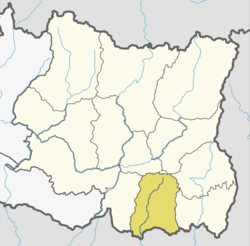Biratnagar
Biratnagar (Nepali: विराटनगर) is a metropolitan city in Nepal, which serves as the capital city[7][8][9] of Province No. 1. With a population of 242,548 as per the 2011 census, it is the largest city in the province and also serves as the headquarters of Morang district.[10] Biratnagar is located 399 km (248 mi) east of the capital, Kathmandu and 6 km (3.7 mi) north of the bordering town of Jogbani in the Indian state of Bihar. The highest peak in the world, Mount Everest, is located 174 km (108 mi) north of the city.
Biratnagar विराटनगर | |
|---|---|
| Biratnagar Metropolitan City | |
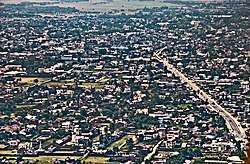 | |
| Nicknames: | |
 Biratnagar Location of Biratnagar in Province No. 1  Biratnagar Biratnagar (Nepal) | |
| Coordinates: 26°27′15″N 87°16′47″E | |
| Country | |
| Province | Province No. 1 |
| District | Morang |
| Incorporated | 1914 (as district headquarters) |
| Upgraded to metropolitan city | 2017 |
| Wards | 19 |
| Government | |
| • Mayor | Bhim Parajuli (NC)[4] |
| • Deputy Mayor | Indira Karki (NC)[4] |
| Area | |
| • Total | 77 km2 (30 sq mi) |
| Elevation | 80 m (260 ft) |
| Population (2011[5]) | |
| • Total | 242,548 |
| • Rank | 1st (Province No. 1) 5th (Nepal)[6] |
| • Density | 3,100/km2 (8,200/sq mi) |
| Languages | |
| • Official | Nepali |
| • Local | Tharu, Bajjika, Bhojpuri, Marwari, Maithili, Limbu, Koche, Urdu |
| Time zone | UTC+5:45 (NST) |
| Postal code | 56600, 56613, 56614 |
| Area code(s) | 021 |
| Website | biratnagarmun.gov.np |
Biratnagar was declared a metropolitan city on 22 May 2017,[11] thus pushing the total population to over 240,000[12] making it the fourth most populated metropolitan city in the country after the urban agglomeration of Kathmandu and Lalitpur, Pokhara, and Bharatpur.
The city is home to the Biratnagar Jute Mills, the first large scale industry of Nepal. It also serves as an entry point to eastern Nepal[13] as well as north-eastern India.[14] Biratnagar is the second Nepalese city, after Janakpur, to have a connection with the Indian Railways[15][16] and the only city after Birgunj to operate an integrated check post (ICP) on the Indian border.[17][18] Considered to be the industrial capital of Nepal, the city is also the birthplace of five prime ministers of Nepal, in addition to being host to a number of revolutionary incidents in the country including the first labor strike which led to the anti-Rana movements.
History
The old name of Biratnagar was Gograha Bazaar. The ruins of temples, palaces and ponds are scattered in a vast area to the south of the current city, in Vedhyari, Buddhanagar. The preservation of these heritages have been a major problem citing the encroachment by newcomers into the city. In 1914, Colonel Jit Bahadur Khatri, the then district governor, laid the foundations of modern Biratnagar by moving the hospital, post office, prison and the customs, land registry, forestry and auditor offices to Gograha Bazaar from Rangeli, the then district capital of Morang.[19] The town was named Biratnagar in 1919 (1976 BS) by Keshar Shamsher Rana after ruins of a palace, thought to be of King Virat, and other objects of historical importance were found.[19] The ruins of the palace along with stone carved tools, idols, and household objects can be seen preserved to the south of Biratnagar, close to the border. In Nepali, Birat (Nepali: विराट) means "Huge" and Nagar (Nepali: नगर) means "City".
On 4 March 1947, the first anti-Rana movement in Nepal started in Biratnagar at the Biratnagar jute mills under the leadership of Girija Prasad Koirala and B. P. Koirala. This sparked a countrywide anti-Rana demonstration that eventually led to the abolishment of Rana rule in Nepal.
Climate
The highest temperature ever recorded in Biratnagar was 43.0 °C (109.4 °F) on the 14 April 1992, while the lowest temperature ever recorded was −1.0 °C (30.2 °F) in December 1970 and January 1971.[20]
| Month | Jan | Feb | Mar | Apr | May | Jun | Jul | Aug | Sep | Oct | Nov | Dec | Year |
|---|---|---|---|---|---|---|---|---|---|---|---|---|---|
| Average high °C (°F) | 22.7 (72.9) |
26.1 (79.0) |
30.9 (87.6) |
33.9 (93.0) |
33.3 (91.9) |
32.9 (91.2) |
32.1 (89.8) |
32.5 (90.5) |
32.1 (89.8) |
31.6 (88.9) |
29.3 (84.7) |
25.4 (77.7) |
30.2 (86.4) |
| Daily mean °C (°F) | 15.8 (60.4) |
18.6 (65.5) |
23.3 (73.9) |
27.1 (80.8) |
28.3 (82.9) |
29.0 (84.2) |
28.8 (83.8) |
29.2 (84.6) |
28.4 (83.1) |
26.4 (79.5) |
22.3 (72.1) |
18.0 (64.4) |
24.6 (76.3) |
| Average low °C (°F) | 9.0 (48.2) |
11.1 (52.0) |
15.6 (60.1) |
20.4 (68.7) |
23.3 (73.9) |
25.2 (77.4) |
25.6 (78.1) |
25.8 (78.4) |
24.7 (76.5) |
21.1 (70.0) |
15.3 (59.5) |
10.5 (50.9) |
19.0 (66.2) |
| Average precipitation mm (inches) | 11.7 (0.46) |
13.2 (0.52) |
13.2 (0.52) |
53.1 (2.09) |
186.0 (7.32) |
302.4 (11.91) |
530.8 (20.90) |
378.3 (14.89) |
298.8 (11.76) |
91.8 (3.61) |
5.9 (0.23) |
6.6 (0.26) |
1,891.8 (74.47) |
| Source: Department of Hydrology and Meteorology (Nepal)[21] | |||||||||||||
Demography
Population and ethnicity
.jpg)
According to 2011 CBS census data, the population of Biratnagar was 214,663.[22] Majority of the people are from the Brahmin and Kshatriya communities. The main language spoken is Nepali. Maithili is also spoken by a sizable proportion of the population. The local indigenous language is Birat Rajbanshi, also known as Khotta/Khoratha. English is well understood by the educated mass. Biratnagar is situated within one of the most ethnically diverse regions of Nepal, and the rural hinterland is home to a diverse cross section of communities.
Religion
Most people practice Hinduism followed by Islam, Jainism, Kirat, and Christianity. Biratnagar is known for its high-spirited festival celebration. During Dashain, the largest festival in the country, a large number of devotees visit the Kali Mandir, a temple dedicated to Goddess Kali, that lies in the heart of the town.

Krishna Janmashtami (the birthday of Krishna) is a major festival celebrated in Biratnagar. Thousands of people gather on the second day of Krishna Ashtami for the holy chariot procession (Nepali: रथ, romanized: Rath) which goes around the city, approximately 8 km (5.0 mi). This event is termed the Rath Yatra (Nepali: रथ यात्रा). It is the largest such procession in Nepal and the second largest in Asia.[23] It is believed that the Rath was driven by Lord Krishna himself. So, a young child is placed in the chariot as a symbol of Krishna and is taken around the city with joy to celebrate Lord Krishna's birthday. Some people stay on top of the Rath to distribute prasad (holy offerings) to numerous devotees observing the holy procession. The Rath is followed by many smaller carts pulled by oxen. People in the smaller carts play music and sing hymns of joy and happiness.
Chhath (Nepali: छठ) is an important festival for Madheshi Hindus, dedicated to the Sun God. The festivities are performed by Hindu women in order to thank Surya (the sun) for sustaining life on earth and to request for certain wishes on the banks of rivers and ponds. Chhath festivities are performed mostly on the banks of Singhiya and Keshalia rivers in Biratnagar.
Ramadan, Eid al-Fitr and Eid al-Adha are celebrated by the Muslim community of Biratnagar. Christmas is also celebrated by a very small population of Christians.
Transport
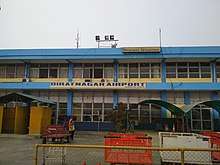
- Air: Biratnagar Airport serves as a regional hub for the eastern part of the country. A subtotal of 10 flights per day are operated to Kathmandu which makes it the busiest domestic airport in the country after Pokhara. Frequent flights are also operated to Tumlingtar as well as other airports within the country.
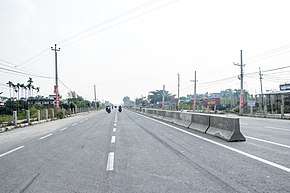
- Road: Biratnagar is roughly 544 kilometres (340 mi) by road from Kathmandu. It is also well connected to all the parts of Province No. 1 including Dharan, Itahari and Dhankuta as well as to most parts of the country through regular bus service. The easternmost border-point of Kakarbhitta lies at a distance of 108 km (67 mi) from the city and can be reached via frequent buses running half-hourly from the buspark.
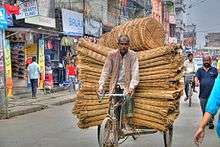
- Trains: There are direct trains from the Indian cities of Katihar, Kolkata and New Delhi to the border town of Jogbani. The rail line ends in Jogbani, Araria district on the Indian side. Biratnagar is 7 km (4 mi) north of Nepal's southern border with Bihar, India. The crossing has a customs checkpoint for goods called as Rani Bhansar.[24] Indian and Nepalese nationals cross the border freely. A monorail extension to Biratnagar has been proposed and surveyed. As of 1 August 2019, the provincial government of Province No. 1 plans to establish a monorail system[25] running 30 km (19 mi) from Rani, Biratnagar to Itahari at an estimated budget of Rs. 30 billion.
- Intracity: Cycle, motor vehicles, rickshaws, and taxis serve the city center. Auto rickshaws (Tempos) are available for longer distances outside the center. City safari or electric rickshaws are the most used transportation here, connect all parts of Biratnagar, and are very cheap as well as environmentally friendly.
Economy
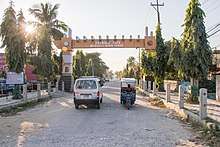
Biratnagar is the economic center of eastern Nepal. The first industry of Nepal, the Biratnagar jute mills, was established here. Biratnagar is driven by startup culture. The multi-million business house, Golchha Organisation, has its roots in Biratnagar where it started as a small startup business. In addition to more than 6000 industries, Biratnagar is connected to a major custom route with India and has the second largest land port in Nepal. Considered to be the industrial capital of Nepal, the unemployment rate in Biratnagar is very low due to large concentration of industries and labour works.
Tourism
Biratnagar is a hub for explorers of places in eastern Nepal like Ilam, Taplejung, Sankhuwasabha and Panchthar. A number of colorful haat bazaars (weekly markets) are held each week in different parts of the town, where farmers from the rural hinterland set up stalls to trade agricultural produce, spices and handicrafts. There are several gardens, temples and places of religious importance in Biratnagar. Gopal garden, located near Hathkhola and Hridreyandra Bal Udhhyan near Thulo Mill are two main gardens. Temples have been the jewel of Biratnagar. They are decorated in vibrant ways to make them attractive.
Dharan is 46 km (30 mi) and Itahari is 24 km (10 mi) north of Biratnagar. These places are famous for Taltalaiya, Ocean Park, Gokulam Resort, Dantakali Temple, Pindeshwor Temple, Budha Subba Temple and Panch Kanya. The hill-station of Bhedetar is a local viewpoint. The tea gardens of Ilam are approximately 4 hours' drive away. Another place of interest is the hilly district of Dhankuta with its orange orchards. The Koshi Tappu Wildlife Reserve, popular with bird-watching enthusiasts, is a 90-minute drive from the city. It is home to the endangered wild buffaloes called "Arna" in Nepali. The largest rhododendron forests of Tinjure, Milke and Jaljale can be reached in about 3–4 hours. Treks with views of Mt. Makalu and Kanchenjunga can be started from the small towns of Basantapur or Tumlingtar.
Politics
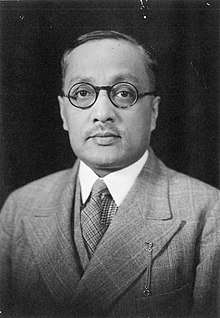
The district headquarters of Morang were moved to Biratnagar from Rangeli in 1914 by the then district governor, Colonel Jit Bahadur Khatri. The next governor, Shiva Pratap Shumsher Thapa, further developed the town.[26] Krishna Prasad Koirala was the first major political leader based in Biratnagar. His sons Matrika Prasad Koirala and Bishweshwar Prasad Koirala were the prime ministers of Nepal after the fall of the Rana rule. Since then Biratnagar has been a major contributor to Nepali politics, and is the most politically active city in the country. Girija Prasad Koirala, the younger brother of Matrika and BP Koirala, was elected prime minister on four occasions; from 1991 to 1994, 1998 to 1999, 2000 to 2001, and from 2006 to 2008.He also served as the acting Head of State from January 2007 to July 2008. Man Mohan Adhikari, the first communist prime minister of Nepal was also born in Biratnagar. Leaders like Bharat Mohan Adhikari, Shailaja Acharya, Sushil Koirala, Lal Babu Pandit, Amod Prasad Upadhyay and Mahesh Acharya all hail from this city. The 1973 plane hijack, which was to fund the political revolution, took place at the Biratnagar Airport. The hijack plan, masterminded by Girija Prasad Koirala, was executed by Durga Subedi, Nagendra Dhungel and Basant Bhattarai.[27]
Nepali Congress's Bheem Parajuli and Indira Karki are the current mayor and deputy mayor of the metropolitan respectively.
Education
Biratnagar is the center of education in eastern of Nepal. Home to the Purbanchal University, Biratnagar has a number of good colleges and educational institutes including medical and engineering institutes. The medium of teaching is English in all the private schools, colleges and universities whereas Nepali is the medium of instruction in government schools up to secondary level. There are more than 80 schools, over 20 colleges and 21 hospitals in Biratnagar, the most after Kathmandu.
Art and literature
Biratnagar has been the ground for many literary personalities: Dev Kumari Thapa, Bal Krishna Pokhrel, Bhanubhakta Pokhrel, Parshu Pradhan, Kabiraj Neupane, Dadhiraj Subedi, Biwas Pokhrel, Nawaraj Subba, Sima Avas, Choodamani Nepal and others. Some of the prominent books in Nepali literature have emerged from Biratnagar. Landmark books in Nepali poetry, Bholi Basne Bihan by Krishna Bhushan Bal and Jeevanko Chheubaata by Suman Pokhrel were published in this city. There is a popular culture of poetry recitation in regular sessions in various locations of Biratnagar.[28]
Sports
Football and cricket are the most popular sports in Biratnagar. Sahid Rangsala with a capacity of 10,000+ spectators is the largest football stadium in the city. Sahid Maidan is the home stadium of Morang Football Club. The Mahendra Gold Cup, now Birat Gold Cup, is held in the stadium along with district divisional league matches. There is a covered hall nearby Sahid Maidan where indoor events can be organized. A cricket stadium is being constructed in Baijanathpur on the outskirts of Biratnagar with the objective of organizing local and national-level cricket tournaments. Other facilities in the city include lawn tennis and basketball courts
Television and radio
- Makalu TV
- Entertainment online radio
- B FM 91.2 MHz
- Radio Star 93.2 MHz
- Koshi FM 94.3 MHz
- Sky FM 106.6 MHz
- Radio Makalu 102.1 MHz
- Radio Purbanchal FM 104.4 MHz
- Radio Purbeli Awaj 98.4
Print and online media
Several local and national daily, weekly and monthly publications are available in the city. Media houses Kantipur, Nagarik, and Aja Ko Samachar Patra print their publications in Biratnagar and distribute throughout eastern Nepal. Local dailies such as Udgosh and Biratpath provide daily news and updates on their websites in addition to their print editions. Local daily newspapers published in Biratnagar include:
- Entertainmentkhabar.com
- New Shristhi Daily
- Birat Sandesh Digital Online
- Ujyalo Patra Daily
- Janabidroha Daily
- Udghosh Daily
- Timesofpurba.com
- Biratpath Daily
- Our Biratnagar
- OnlyKhabar Media
Notable residents
- Amod Prasad Upadhyay, Nepali Congress politician
- Arunima Lamsal, actress
- Bhola Rijal, gynaecologist and poet
- Bhola Silwal, footballer
- Bharat Mohan Adhikari, CPN (UML) leader
- Bishweshwar Prasad Koirala, 22nd Prime Minister of Nepal and a psychoanalytic writer
- Deepa Shree Niraula, actress
- Girija Prasad Koirala, 30th Prime Minister of Nepal
- Lal Babu Pandit, Nepal Communist Party politician
- Mahesh Acharya, Nepali Congress politician
- Man Mohan Adhikari, 31st Prime Minister of Nepal
- Matrika Prasad Koirala, 18th Prime Minister of Nepal
- Ranu Devi Adhikari, singer
- Shailaja Acharya, Nepali Congress politician
- Shekhar Koirala, Nepali Congress politician
- Shilpa Maskey, actress
- Shiv Shrestha, actor
- Siddhant Lohani, cricketer
- Sugam Pokharel, singer
- Sujata Koirala, Nepali Congress leader
- Suman Pokhrel, poet, lyricist, playwright
- Sunil Pokhrel, actor
- Sushil Koirala, 37th Prime Minister of Nepal
- Tarini Prasad Koirala, Nepali Congress leader
- Yuvaraj Adhikari, Nepali Congress leader
References
- ""Biratnagar is the most industry-friendly city in Nepal" | New Business Age - monthly business magazine in English published from Nepal". www.newbusinessage.com. Retrieved 2018-04-21.
- "Biratnagar, so special to Nepal's industrial history". Retrieved 2018-04-21.
- "Flights To Biratnagar - Book Tickets Online To Biratnagar | Buddha Air". www.buddhaair.com. Retrieved 2019-07-28.
- "विराटनगर महानगरपालिका गृहपृष्ठ". विराटनगर महानगरपालिका. Retrieved 2018-10-28.
- "National Population Census 2011" (PDF). Archived from the original (PDF) on 24 January 2013. Retrieved 6 November 2012.
- "स्थानीय तहहरुको वस्तुगत विवरण २०७४ (Local Level Profile)" (PDF). ddcmorang.gov.np.
- "Biratnagar celebrates its status of provincial capital". thehimalayantimes.com. 19 January 2018. Retrieved 19 January 2018.
- "Locals intensify protest in Dhankuta after Biratnagar named as provincial HQ". kathmandupost.ekantipur.com. 19 January 2018. Retrieved 19 January 2018.
- "Nepal government announces Provincial Capitals and Chiefs". ddinews.gov.in. 17 January 2018. Retrieved 19 January 2018.
- "विराटनगर महानगरपालिका | नेपाल सरकार". biratnagarmun.gov.np. Retrieved 2017-01-22.
- "Archived copy". Archived from the original on 2017-05-22. Retrieved 2017-06-01.CS1 maint: archived copy as title (link)
- "Archived copy". Archived from the original on 2017-11-14. Retrieved 2017-06-01.CS1 maint: archived copy as title (link)
- "Things to Do & Places To Visit Near Biratnagar Nepal". 2018-08-11. Retrieved 2019-06-15.
- Tripoto. "Weekend Getaways from Biratnagar: Places to Visit Near Biratnagar, Getaways from Biratnagar". Tripoto. Retrieved 2019-06-15.
- Subedi, Binod. "Biratnagar town connected with Indian railway network". My Republica. Retrieved 2019-06-15.
- "1st cargo train arrives near Biratnagar". kathmandupost.ekantipur.com. Retrieved 2019-06-15.
- "Biratnagar ICP to be operational from next week". GorakhaPatra. Retrieved 2020-01-19.
- "PM Oli, Modi to inaugurate Biratnagar ICP via video conferencing". Khabarhub English News. 2020-01-18. Retrieved 2020-01-19.
- Dambar Krishna Shrestha & Kamal Rimal. "१०० वर्षको विराटनगर, मणि खोज्दै (Biratnagar Turns 100, Seeking Glory)". Himal Khabar. Himal Media. Retrieved 26 December 2013.
- "Archived copy" (PDF). Archived from the original (PDF) on 2016-03-04. Retrieved 2016-02-27.CS1 maint: archived copy as title (link)
- "Normals from 1981-2010" (PDF). Department of Hydrology and Meteorology (Nepal). Retrieved 20 October 2012.
- "National Population Census 2011"
- https://2018.biratnagar.wordcamp.org/12-facts-about-biratnagar/
- "Biratnagar Custom Biratnagar, 'Department of Customs Biratnagar Customs Office'". customs.gov.np. Retrieved 2020-02-16.
- "The Rising Nepal: '70 per cent of estimate cost for the monorail project in Biratnagar secured'". therisingnepal.org.np. Retrieved 2019-07-28.
- "Biratnagar : The Heart-throb of Eastern Nepal". DWIT News. 7 September 2015. Archived from the original on 21 October 2016. Retrieved 20 October 2016.
- "Documentary on Nepal plane hijacking screened". The Kathmandu Post. Retrieved 2020-06-18.
- Dadhiraj Subedi, "नेपाली साहित्यका मुस्कानहरू (The Smiles of Nepali Literature)"- 2012, Purwanchal Sahitya Academy, Biratnagar - ISBN 978 9937248266
External links
| Wikimedia Commons has media related to Biratnagar. |
| Wikivoyage has a travel guide for Biratnagar. |

